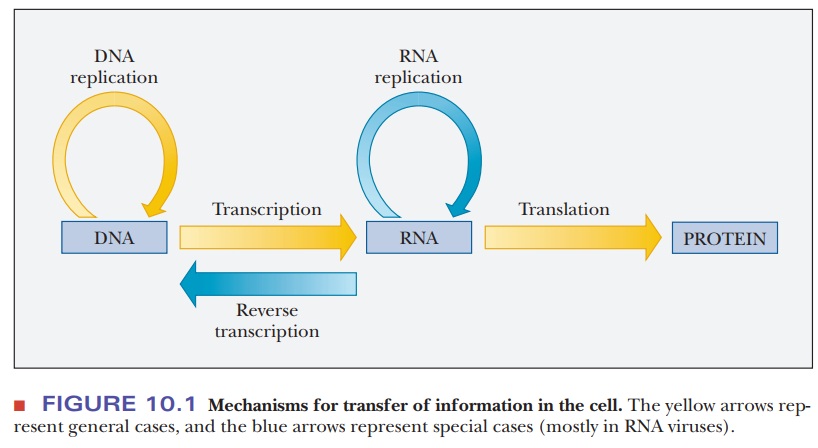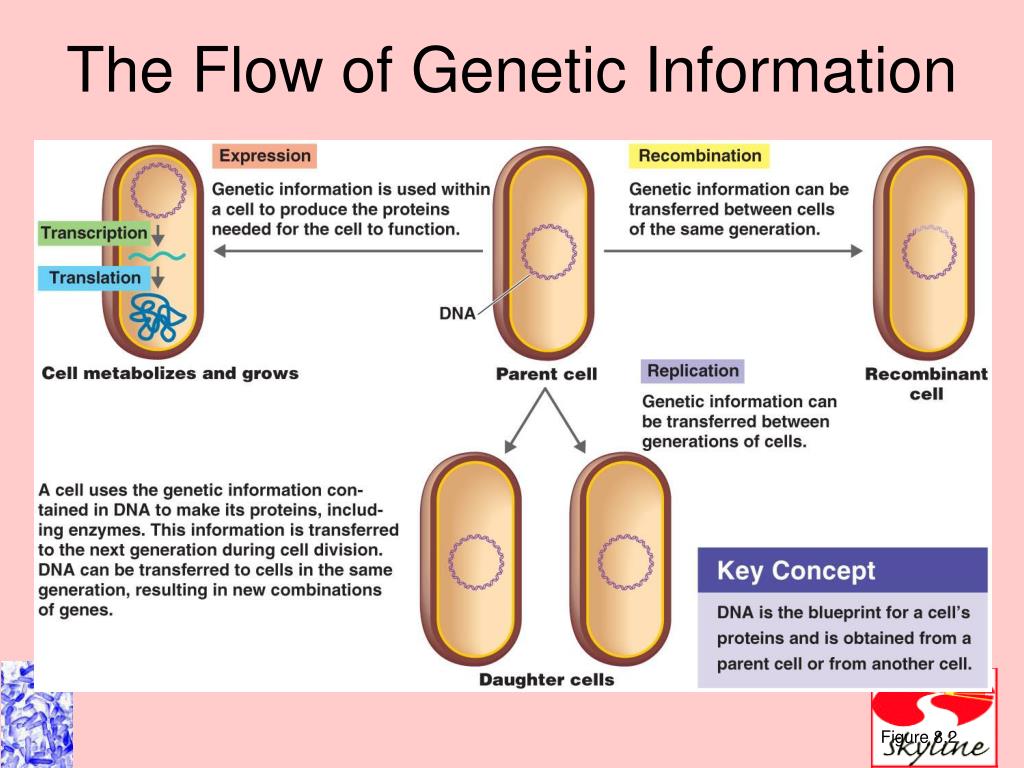The Flow Of Genetic Information In A Cell Goes From

The intricate dance of life within our cells hinges on a fundamental principle: the flow of genetic information. Misunderstandings or disruptions of this flow can have devastating consequences, leading to diseases like cancer, genetic disorders, and even cellular death. Understanding this central dogma is crucial for advancing medical treatments and unraveling the mysteries of our own existence.
At its core, the flow of genetic information describes how instructions encoded in DNA are used to build the proteins that perform nearly every function in a cell. This process, often referred to as the central dogma of molecular biology, involves two key steps: transcription and translation. It's a highly regulated and complex mechanism, crucial for maintaining cellular health and function. We will delve deeper into the components and processes that govern this information flow.
The Players: DNA, RNA, and Proteins
DNA: The Blueprint of Life
DNA (deoxyribonucleic acid) serves as the cell's master blueprint, containing the complete set of genetic instructions needed to build and operate an organism. This double-stranded helix resides primarily within the nucleus of a cell, protected from damage and readily accessible for replication and transcription. Its sequence of nucleotide bases (adenine, guanine, cytosine, and thymine) dictates the order of amino acids in proteins.
Think of DNA as the original architectural plan for a building. It contains all the details, specifications, and instructions required for construction. Maintaining the integrity of DNA is paramount for ensuring that the correct instructions are passed on to future generations of cells.
RNA: The Messenger and Translator
RNA (ribonucleic acid) acts as an intermediary between DNA and proteins. There are several types of RNA, each with a specific role in the flow of genetic information. Messenger RNA (mRNA) carries genetic information from DNA to the ribosomes, where proteins are synthesized.
Transfer RNA (tRNA) brings amino acids to the ribosomes, matching them to the mRNA sequence. Ribosomal RNA (rRNA) is a key component of ribosomes themselves, providing the structural and catalytic machinery for protein synthesis. These different types of RNA work together to ensure accurate and efficient translation of genetic information.
Proteins: The Workhorses of the Cell
Proteins are the functional molecules of the cell, carrying out a vast array of tasks. They act as enzymes, catalyzing biochemical reactions; structural components, providing support and shape to cells and tissues; and signaling molecules, transmitting information between cells.
The sequence of amino acids in a protein, determined by the DNA sequence, dictates its unique three-dimensional structure and function. Errors in protein synthesis can lead to misfolded proteins, which can disrupt cellular processes and cause disease. In essence, proteins are the workers who bring the DNA blueprint to life.
The Process: Transcription and Translation
Transcription: From DNA to RNA
Transcription is the process of copying the genetic information from DNA into mRNA. This process occurs in the nucleus and is catalyzed by an enzyme called RNA polymerase. The RNA polymerase binds to a specific region of DNA, unwinds the double helix, and synthesizes an mRNA molecule complementary to the DNA template.
Think of transcription as making a photocopy of a specific page from the architectural plan. This photocopy, the mRNA, can then be transported out of the nucleus to the construction site (the ribosome). The mRNA is a temporary and mobile version of the genetic instructions.
Translation: From RNA to Protein
Translation is the process of decoding the mRNA sequence to synthesize a protein. This process takes place in the ribosomes, which are located in the cytoplasm. The ribosome reads the mRNA in three-nucleotide units called codons, each of which specifies a particular amino acid.
tRNA molecules, each carrying a specific amino acid, recognize and bind to the corresponding codon on the mRNA. The ribosome then joins the amino acids together, forming a polypeptide chain that folds into a functional protein. Translation is like the construction crew reading the photocopy and assembling the building according to the instructions.
Reverse Transcription: An Exception to the Rule
While the central dogma typically describes the flow of information from DNA to RNA to protein, there are exceptions. Reverse transcription is the process of synthesizing DNA from RNA. This process is carried out by retroviruses, such as HIV, which use an enzyme called reverse transcriptase to convert their RNA genome into DNA.
The viral DNA is then integrated into the host cell's genome, allowing the virus to replicate. Understanding reverse transcription is crucial for developing antiviral therapies that target reverse transcriptase. This exception highlights the adaptability and complexity of genetic information flow in different organisms.
Implications for Health and Disease
Disruptions in the flow of genetic information can have profound consequences for health and disease. Mutations in DNA can lead to errors in transcription and translation, resulting in the production of non-functional or harmful proteins. These mutations can cause a wide range of genetic disorders, including cystic fibrosis, sickle cell anemia, and Huntington's disease.
Cancer is often caused by mutations in genes that control cell growth and division. These mutations can lead to uncontrolled cell proliferation and the formation of tumors. Understanding the flow of genetic information is crucial for developing targeted therapies that specifically target cancer cells.
Looking Ahead: Future Directions in Research
Research continues to deepen our understanding of the flow of genetic information. Scientists are exploring the role of non-coding RNAs in regulating gene expression. They are also developing new technologies for editing genes, such as CRISPR-Cas9, which holds tremendous potential for treating genetic diseases.
Furthermore, advancements in proteomics are allowing scientists to study the structure and function of proteins in unprecedented detail. These advancements promise to revolutionize our understanding of cellular processes and lead to the development of new and more effective treatments for a wide range of diseases. By unraveling the intricate details of this flow, we can unlock new possibilities for improving human health and well-being.











.png)






